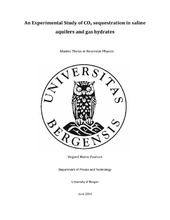| dc.description.abstract | Processes related to the displacement of brine by CO2 were studied in core flood experiments in high-permeable, homogeneous Bentheim sandstone using a medical CT scanner. These processes are of high relevance for prediction of CO2 storage capabilities and flow functions related to plume- migration of carbon dioxide injection in saline aquifers. Both saturated and unsaturated CO2 and brine phases were injected in the rock with rates ranging from 0.1-70ml/min. The experimental pressures and temperatures range from 9MPa to 10MPa and 25<degrees>C to 50<degrees>C, respectively, resulting in realistic CO2 sequestration conditions for both supercritical and liquid CO2. The experimental system used in the experiments was built specifically for these experiments, something considered quite challenging. Saturation profiles and fluid distributions, residual saturations and capillary pressure curves were extracted from CT data and differential pressures over the core. A time-efficient method emulating a spontaneous imbibition process was successfully utilized: slugs of brine were injected prior to stepwise decreasing rates of CO2 injection. The method used to obtain capillary pressure data is a fairly new method where capillary pressure curves can be measured in as little as 10 hours, with the sample remaining intact. Residual CO2 saturations of up to 21.9% of pore volume were observed throughout the experiments, with the highest value coming from the liquid CO2-brine displacements. Viscous displacement seemed to be the main driving force of the displacements and corresponded well with changes in differential and absolute pressure. The possibility of storing CO2 in natural gas hydrate systems was studied by injecting liquid CO2 in a Bentheim sandstone core with preformed methane hydrate. The temperature was 4<degrees>C and the pressure was 86bar. It is previously shown that a spontaneous exchange process between carbon dioxide and methane takes place due to carbon dioxide being a more thermodynamically stable hydrate former than methane, resulting in safe carbon dioxide storage in hydrate form and a recovery of methane. It was observed that CO2 flowed through the system and also remained in the core after the injection and estimates were made regarding the amount stored in hydrate and as free gas in the pores. | en_US |
